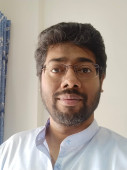
Biswanath Maity
Professor
Biswanath Maity
Professor, Biological Sciences
PhD: Calcutta University, 2010
Previous appointments:
Personal Webpage: Click Here
Research interests:
Personal Webpage: Click Here
Contact:
| Address: |
Biological Sciences Unified Academic Campus Bose Institute EN-80, Sector V Bidhan Nagar Kolkata - 700 091, India |
| E-Mail: | bmaity[at]jcbose.ac.in |
Research:
Recognition:
Teaching:
Students:
| Image | Name | Designation | Department | Campus | Contact number | |
|---|---|---|---|---|---|---|
 |
Arghya Acharyya | Junior Research Fellow | Biological Sciences | Unified | acharyayaarghya@gmail.com | |
 |
Pallobi Khatua | Junior Research Fellow | Biological Sciences | Unified | pallobikhatua3@gmail.com |